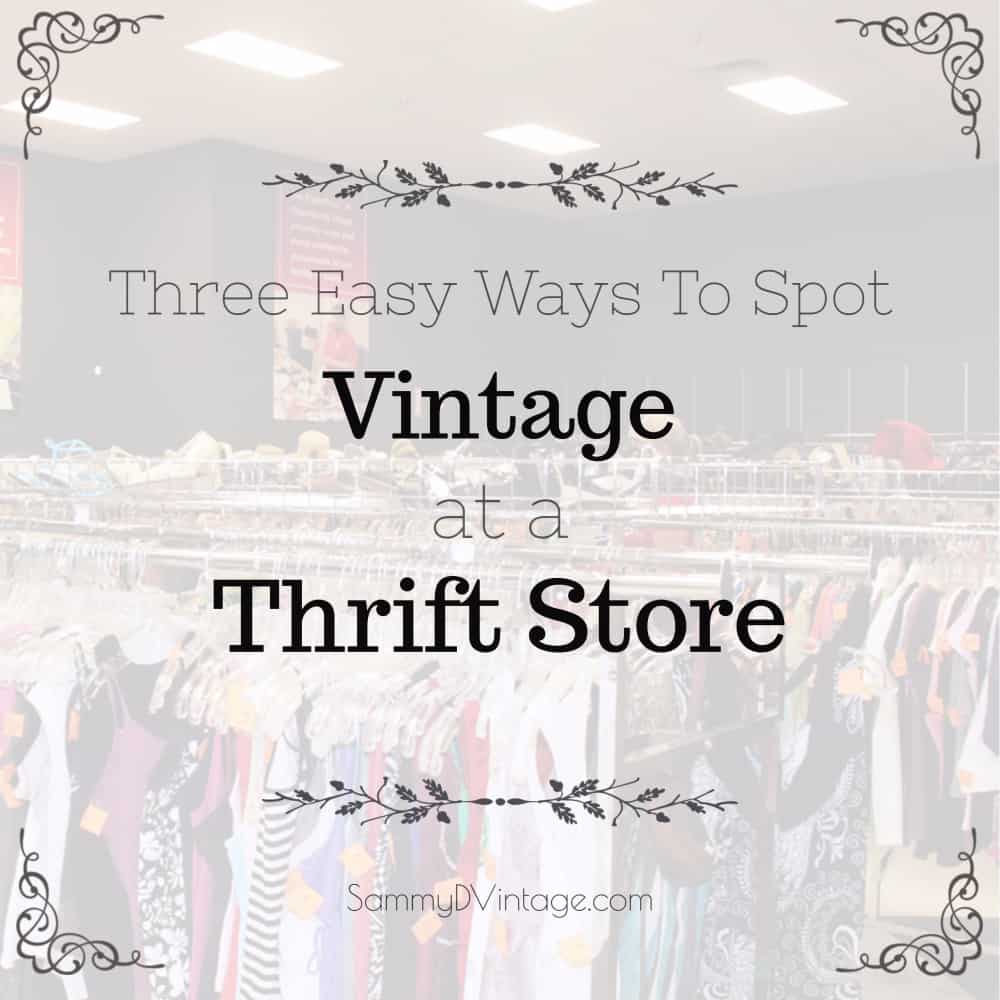
You’re thrift store shopping at your favorite store — like the Salvation Army I love in my hometown of Lancaster, Pennsylvania — when a unique looking garment catches your eye from between the racks. You pull the garment toward you, revealing a gorgeous silk dress with lucite buttons in an aquamarine blue color that resembles a shirtwaist style popular in the 1950s. Excitedly, you move in to examine the garment’s designer, expecting to see a high-brow name or at the very least, a boutique label on such an exquisite piece.
But when you peer into the garment to examine the tag, you notice a foreign looking logo with a designer you’ve never seen before. You show the tag to your thrift shopping partner to see if she’s ever seen anything like it before. She says that “No she has not, but do you think the piece might be vintage?” She has a good point, but how are you to know if you don’t know how to identify or date vintage clothing. So you toss the dress into your cart for purchase without ever knowing its true vintage identity.
Since so many thrifters aren’t vintage clothing experts but repeatedly experience the scenario above in their thrifting travels, I wanted to share three easy ways to spot vintage clothing in a thrift store so that no matter your experience level, you can have more confidence knowing that a foreign looking label is that of a vintage clothing garment. For tips on how to spot vintage in a thrift store, keep reading after the jump for insights on vintage clothing union tags, brand designs and Made in USA labels!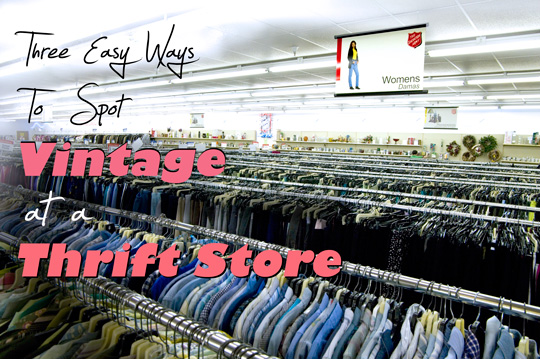
Deciphering the vintage era of a garment is like putting together a gigantic puzzle. The more missing pieces you uncover, the clearer the picture and the more confident your answer feels. While these three tips won’t tell you the exact year or even the definitive era of a piece, they will point your detective skills in the right direction of where to learn more so that you can decide the true vintage style origin of your thrift store find for yourself. What are your tips for spotting vintage in a thrift store? Do you have a special strategy that I missed here?
Let me know in the comments below the post, or share your advice and insights with me on Facebook, Twitter or via email. And don’t forget to follow me on Instagram!
Plus, stay tuned for a future post on thrift store shopping vintage labels and tags for the advanced!
xx, SD
Vintage Fashion Tips
UNION LABELS
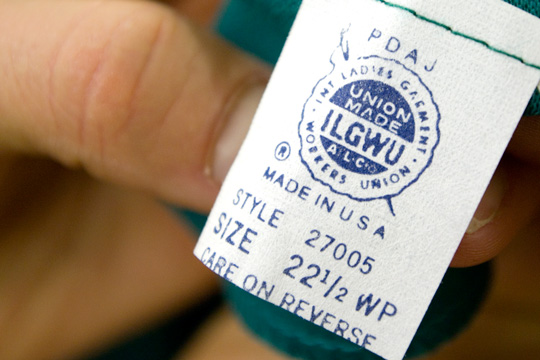
THE SIGN: While you’re combing the racks and flipping through pieces, you spot a tiny, funny looking tag you’ve never seen before with the acronym “ILGWU” on it. What you’ve just found is a “union” tag, identifying the piece as clothing made by a group of American workers who have banded together (“unionizing”) for better employment opportunities and fair wages.
HOW TO SPOT IT: Look for union tags sewn immediately behind or next to the designer/label tag of a clothing garment. A union tag’s design features a scalloped circle with a threaded needle diagonally behind it. In the center are the large letters ILGWU (International Ladies Garment Workers Union) crossed with the smaller acronym AFL-CIO. Around the edge is printed “Int’l Ladies Garment Workers Union.” Union tags were printed in a variety of colors, so don’t be surprised if you find red, black, blue or green printed on a white tag. Plus, a bonus for the more advanced: A tag’s color can help shed light on the era a piece was most likely made.
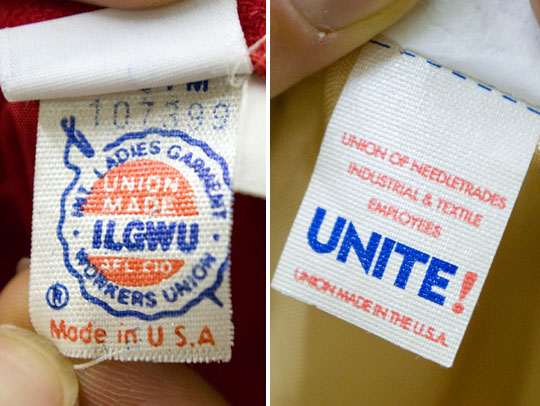
VINTAGE FASHION TIPS: If the piece has a “union” tag sewn on its inside, you can confidently assume that it’s vintage. This is because beginning in the ’80s, most clothing was not produced by a clothing union and was rather outsourced for cheaper labor abroad. But before the majority of our clothing was made in Asian countries, the ILGWU employed the women who manufactured American clothing available for purchase at mainstream stores. In the ’70s and earlier, anything not made by the union was most likely handmade by a specialty dressmaker or sewn together using a pattern by the wearer of the garment herself. Since the ILGWU was founded in 1900, the design of its union tags have changed several times and it’s these changes which tell vintage clothing collectors the approximate era a piece was produced. These tips are better suited for the advanced thrifter, so be on the lookout for my upcoming post on advanced labels and tags identification. Here is your guide to identifying the era of an ILGWU union label!
BRAND LABELS
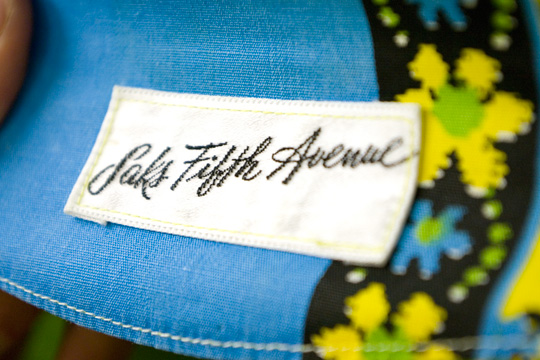
THE SIGN: “Ooh! Saks Fifth Avenue, what a SCORE!” You think to yourself after spotting a bonafide Saks dress sold for a steal in the racks of your favorite thrift store haunt. But then you furrow your brow in puzzlement: This doesn’t appear to be the Saks label you know and love. Could it be a knock-off instead? Most likely it’s not a knock-off, but rather Saks from a vintage era! When you spot a recognizable brand with a clothing label not seen in stores today, chances are you’ve come across a piece from its vintage clothing archives.
HOW TO SPOT IT: When thrift store shopping, give each designer/label tag a second glance to identify whether it’s of modern design. If your label’s modernity seems questionable, look up the brand name in the Vintage Fashion Guild’s label resource guide to compare your label’s design next to the pictures available. Noting similarities between your tag and the vintage examples will help you to decide whether you’ve discovered a vintage piece or not. The VFG’s label resource guide visually chronicles the various label designs of popular designers and brands, from icons such as Chanel, Diane von Furstenberg and Betsy Johnson to mall stores like The Gap, Abercrombie & Fitch and Banana Republic.
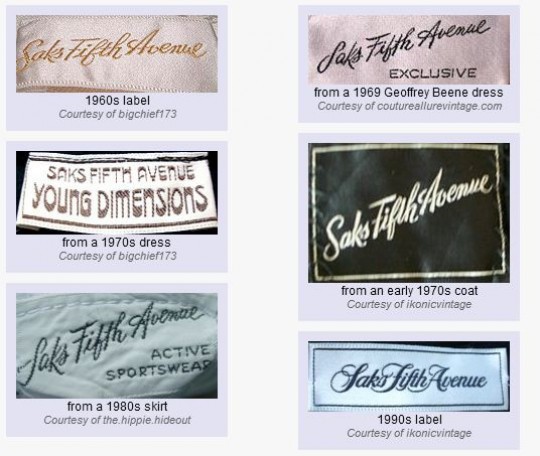
Source: The Vintage Fashion Guild
VINTAGE FASHION TIPS: Brands often change the design of their labels to redefine their image and to differentiate between separate clothing lines under the major umbrella of one company. With an illustrious 90-year-old history, Saks Fifth Avenue has presumably changed its tag design numerous times. Compare the Saks tag shown above to some of the tags from the 1960s on the Vintage Fashion Guild’s guide. Note the similarities in font and how the words are placed at a diagonal from bottom left to an upper right. Using this information, it’s safe to assume that based on the tag’s design, that this Saks Fifth Avenue label is from the late ’60s – early ’70s. To more accurately mark the era of the piece itself, you’d consider other characteristics of the garment (style, material, construction) to confirm its true vintage era.
MADE IN THE USA
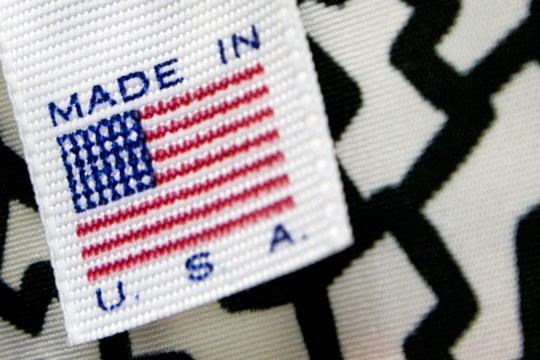
THE SIGN: It’s a glorious privilege to be born as a — and thrift! — a Made in the USA item. When you discover vintage amongst the racks, chances are you’re touching an American made product since offshore production didn’t dominate the clothing industry until the ’80s. Since vintage clothing is best described as any item of the ’80s or earlier (following the 20 year rule), you should keep your eyes peeled for any American flag designs or locally made mentions on a garment’s tag to help identify it as vintage.
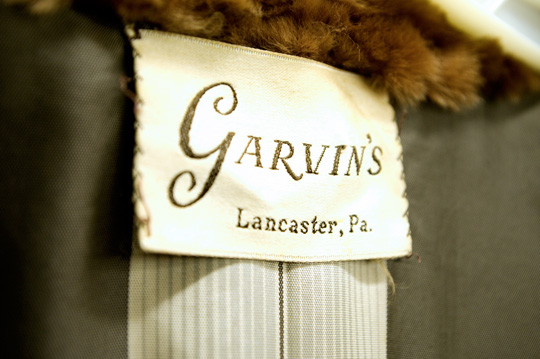
HOW TO SPOT IT: Older vintage pieces produced before the ’80s might have a “city/town, state” (like “Lancaster, Pa” above) reference on its tag. Pieces made in the ’80s are tagged with a separate label that states “Made in USA” with an American flag emblem, or text stating “Made in the USA” printed alongside the brand name on the tag.
VINTAGE FASHION TIPS: Beginning in the ’60s, clothing production in the US began to be outsourced for cheaper labor opportunities. It began with production outsourced only to Japan in the 1960s but by the ’80s and into the ’90s, most clothing was made in Taiwan, China, Eastern European, Singapore, Malaysia, China and Indonesia with hardly any left over to be produced in the good red, white and blue. By the late ’70s, a campaign to support American made textiles had mushroomed and brands were promoting their patriotic allegiance to stateside manufacturing with red, white and blue tags like the one shown above. Before the ’80s-current eras of outsourcing clothing production abroad, specialty stores produced garments locally and so for the wearer’s reference, listed where it was made (by city and state normally) so they could remember where to visit the shop again. Remember, this was a time before digital yellow pages on the Internet!
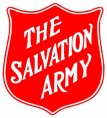
Thank you to the Salvation Army of Lancaster, PA for permission to shoot photos in their store.
MORE VINTAGE FASHION SECRETS
How to Date Vintage Clothing The ILGWU Union Label
Guide for Identifying Clothing Era
What is Deadstock Vintage? Vintage Tag History
Banana Republic, Betsy Johnson, Levi’s & More The 7 Secrets to Pricing Vintage Fashion
Vintage Fashion Guild: Label & Tag Resource Guide
PLUS: Thrift Store Shopping Like a Pro Series

Very helpful. Thank you.
No problem Juneque Gypsy! Thanks so much for stopping by and commenting ;-)
Those are definitely the best immediate “tells” for vintage. I’ve noticed, however, that a lot of new lines coming out of Korea, Japan and China have the look of vintage and they even try to replicate the old fashioned style of the tags!
The true giveaway many times are the materials, as Cheryl has mentioned. Anything before the 70s, the finishes on the garments will be hand-sewn or the stitching done extremely well compared to today’s fast-fashion manufacturing. There are obviously exceptions to this, but you want quality anyway if you want it to continue its life in your closet.
For 70s and later, I still base it on the quality of the materials and finishes, or the uniqueness of the design, but the materials are typically just of a higher quality than what is produced today and sewn better. Just touch it and touch something from Forever 21 and you’ll get it.
Vintage knock-offs are made with cheap fabrics and have poor construction, and sloppily-sewn machine stitching.
hey Stephanie! That’s very true about new lines produced abroad that look and feel ‘vintage.’ I hate to call out a particular brand, but Anthropologie does an eerily good job of this!
Thank you so much for adding your wisdom to this post — I hope readers read this, learn and use it! xx
I’ve definitely noticed the “Made in U.S.A.” and union-made labels when I’m vintage shopping. And it’s good to know that my Sak’s dress is probably from the early 1990s!
Great post, once again!
Hey E! That’s great news!!! Hey, early ’90s is vintage now … technically speaking anyway ;-) Thank you for the support!
I think I need to make a trip down to PA because I rarely see “a gorgeous silk dress with lucite buttons in an aquamarine blue color” hiding in an NYC thrift store! Another great article, Sammy. Sometimes I feel like I am naturally gravitated towards vintage as I always manage to pull out something pre-1970 when I am out and about thrifting or at a fleamarket. I always look for things I love like bright colours, floral, gingham, or polka dot prints, fit and flare shapes and metal zippers. Its always exciting to peer inside a garment and see a union label or a super classic label in that perfect vintage script! ;)
Sara, you would absolutely love Lancaster! Also, Adamstown, PA is 20 miles way from Lancaster and it is the “antiques capital of the East Coast.” Google it and you will find a lot of information about flea markets, stores, antique malls, etc. in that area. My hometown is only 3 hours away by train … someday you should visit with me! xx
For vintage t-shirt enthusiasts, this is a helpful guide. It’s usually easy to tell a homemade iron-on from a quality print, but this gave me some other things to think about. Thanks for breaking it down by decade.
Not a problem Adam ;-) Thanks so much for reading and commenting!
This is the best site you will ever find for dating vintage clothing. Click on VTG resources then labels, awesome.
Mike, it truly IS! I agree! I use it so often! I wish the tags-labels was an iPhone app ;-)
VERY helpful! Thanks for posting, Sammy!
Best,
Heather
Thank you so much for commenting and letting me know, Heather! ;-) Happy vintage hunting!
Best vintage item I ever found was a Dior robe with a ILGWU tag in it…awesome. Gotta love thrifting!
Support small fashion business! http://peerbackers.com/projects/qf-clothings-growth-helps-mom-stay-home-with-baby/
http://stores.ebay.com/QFClothing
Ooh! Thank you for sharing Alicia! Keep up the good finds ;-) thrift Gods a blessin’ XO
Can you tell me what the Style Number and Vendor numbers on garment tag represent? I see theses on a lot of cloths I am preparing for sale on eBay and was wondering if these numbers are traceable. I was able to find the RN looup database but no luck on the others. I was hoping the Style# would reveal the color description on the garment.
Magda I will be honest with you, I have yet to figure that out. I think it has something to do with how many styles they made per “collection” per “calendar year” or perhaps the style number for their production schedule in a factory. The RN loop database really isn’t all that accurate either … I’ve found it’s better for accuracy not to even use that tip but rather to go with style and construction instead, or to use the US Patent Website (you can use Google’s Patent website too) to look up the designer itself and learn when the patent was made and when it died to give you a better “window” of time. It’s nailing down that ONE year it was made which is so difficult! I love the tags that literally have a copyright year on them (was popular in ’90s, for some reason)
Can you tell me what the Style Number and Vendor numbers on garment tag represent? I see theses on a lot of cloths I am preparing for sale on eBay and was wondering if these numbers are traceable. I was able to find the RN lookup database but no luck on the others. I was hoping the Style# would reveal the color description on the garment.
Hi Sammy,
Is there any book that you could recommend to me if i want to refer on vintage tags & labels?
TQ
Unfortunately, when garment production went overseas, the quality, for the most part, went way down.
For example I have a few garments from Lands End that were made in the USA, before Lands End outsourced almost everything. The USA made garments from the early 90s, even after many, many washes are heavier and better constructed than the equivalent styles of today. The present day Lands End garments are reasonably well made, but up against their former USA made garments, there is no contest as to which is better.
Heya terrific website! Does running a blog like this require a massive amount work?
I’ve no expertise in programming however I had been hoping to start my own blog in the near future. Anyways, should you have any suggestions or techniques for new blog owners please share. I know this is off topic nevertheless I just had to ask. Thank you!
My website Boost Your Apparel Line With Business Playing Cards
hello, I was wondering if you could help me out identifing an item, I found a mens sweater and it has an inside union label in the seam, I cannot make out the top inside tag, if I send you photos I was hoping you could tell me a little about it
best regards
We own a designer consignment boutique and was in need of some information regarding designer labels. We understand that each brand changes there label each calender year? Is this correct?
If so is there a source where I could obtain this information?
Another Look Boutique
Leesburg Florida 34748
My mother recently passed away and she left me her entire wardrobe. My mother lived a wealthy lifestyle and her wardrobe cost a fortune. However, my life, though its been blessed, has not brought me the multiple milion dollar mansions or extensive walk~in closets that she had. In fact, I am oblivious to the fashion world. I do know by some of the brand names like; burberry, Christian dior, saks fifth, liz Claiborne, coach, Neiman Marcus, etc, and know they were not cheap. Nothing my y mother did was cheap. My mom was 76 when she passed so many of her 1000+ garments in her wardrobe are certainly vintage. I was going to drop most of it off at goodwill but havent cuz I new I was loosing a fortune by doing so. Can you help me? I would be willing to split the profit with you and since it was all free for us both then theres nothing but profit to gain. Let me know asap cuz its taking over my entire house. There are clothes in every room, every couch, chair, bed…. I am going crazy drowning in clothes.
I look forward to hearing back from you.
Sincerely yours,
Katie
Hello Sammy. I am having difficulty dating a beautiful tie neck wool blazer with metal buttons (a thrift store find) made by Mig Wear New York. It has a Made in USA tag sewn into the side seam, which also indicates the fabric content.
In what decade were these labels sewn into the side seams?
Thank you!
Thank you for this helpful article! The label resource guide was especially handy. I just opened my shop on DePop and I know this will be a great “fashion field guide” in my thrift-ventures!
Hello Sammy ,I’m trying to date vintage union long John’s, Utica, Morgan,j.c.lenny,Health, and white mountain trading company..
Thank you so much for this helpful article!!!